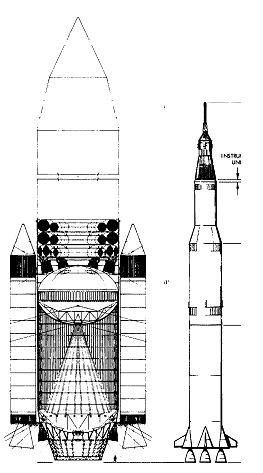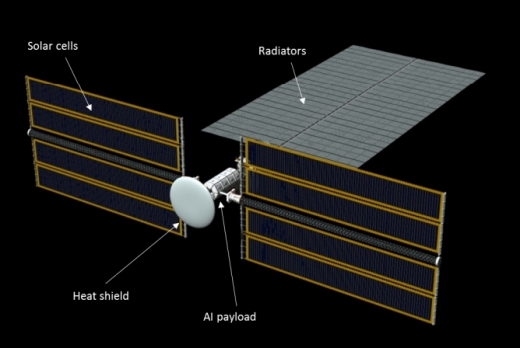I think the theory of quantised inertia is worth looking into experimentally. It does appear to offer the promise of some degree of control over the inertial mass of a body as well as holding out the possibility of reactionless propulsion.
-
Welcome! The TrekBBS is the number one place to chat about Star Trek with like-minded fans.
If you are not already a member then please register an account and join in the discussion!
You are using an out of date browser. It may not display this or other websites correctly.
You should upgrade or use an alternative browser.
You should upgrade or use an alternative browser.
What dream tech would you like to see?
- Thread starter Candleicious Ghost
- Start date
Might explain several anomalies too.I think the theory of quantised inertia is worth looking into experimentally. It does appear to offer the promise of some degree of control over the inertial mass of a body as well as holding out the possibility of reactionless propulsion.
One experimental observation it might have problems with is explaining the distribution of gravitational lensing in the Bullet Cluster of galaxies. I haven't seen a discussion of that anywhere.Might explain several anomalies too.
The theory does, however, do better than the MOND and dark matter theories at explaining other galaxy interactions, galaxy rotation, globular cluster dynamics, and wide stellar binaries.
It's a very intriguing proposition. I can't see anything intrinsically wrong with it. I believe efforts are currently under way to see if it can be falsified.
Last edited:
DARPA funded a small study beginning late last year.I believe efforts are currently under way to see if it can be falsified.
A vending machine for partners
Well, if I had to pick between some kind of gravity control, but that can only come after 200 years of research--or the American public funding AMLLV now--I'll take the rocket:
https://www.secretprojects.co.uk/fo...HPSESSID=gbpl01c3ukc98jkh3ekqi9qki5#msg125909

"It would put about 4 million pounds (1,800~ tonnes) into LEO with each launch using a single 8 million pound thrust toroidal aerospike LOX/LH2 engine in the central stage."
Go ahead Kang and Kodos from the Simpsons--go try your inertia dampener on that.
https://www.secretprojects.co.uk/fo...HPSESSID=gbpl01c3ukc98jkh3ekqi9qki5#msg125909

"It would put about 4 million pounds (1,800~ tonnes) into LEO with each launch using a single 8 million pound thrust toroidal aerospike LOX/LH2 engine in the central stage."
Go ahead Kang and Kodos from the Simpsons--go try your inertia dampener on that.
Well, if I had to pick between some kind of gravity control, but that can only come after 200 years of research--or the American public funding AMLLV now--I'll take the rocket:
https://www.secretprojects.co.uk/fo...HPSESSID=gbpl01c3ukc98jkh3ekqi9qki5#msg125909

"It would put about 4 million pounds (1,800~ tonnes) into LEO with each launch using a single 8 million pound thrust toroidal aerospike LOX/LH2 engine in the central stage."
Go ahead Kang and Kodos from the Simpsons--go try your inertia dampener on that.
I saw a video on youtube about aerospike engines. Hang on.
Probably going to need a new launch site well away from populated areas -- as for Orion nuclear pulse propulsion or Sea Dragon. Would launching from water as for Sea Dragon be possible? I assume any ice buildup can be overcome by suitable engineering. The negative environmental impact might be significant, of course.Well, if I had to pick between some kind of gravity control, but that can only come after 200 years of research--or the American public funding AMLLV now--I'll take the rocket:
https://www.secretprojects.co.uk/fo...HPSESSID=gbpl01c3ukc98jkh3ekqi9qki5#msg125909

"It would put about 4 million pounds (1,800~ tonnes) into LEO with each launch using a single 8 million pound thrust toroidal aerospike LOX/LH2 engine in the central stage."
Go ahead Kang and Kodos from the Simpsons--go try your inertia dampener on that.
Sea Dragon, as proposed, used a first stage RP1/LOX pressure-fed engine with a single huge engine bell, which would be a lot simpler than an aerospike. The second stage engine was an LH2/LOX single engine and the payload to LEO was 550 metric tons. For comparison, the ISS has a mass of about 420 metric tons.
I assume recovery of the single stage and boosters of an AMLLV would be desirable and not create too much of a weight penalty.
Last edited:
I assume recovery of the single stage and boosters of an AMLLV would be desirable and not create too much of a weight penalty.
Reusability can mean two things. Landing said rocket--or making it stage and a half so as to take the rocket body itself into orbit as a wet stage station module. I prefer the latter myself..
Some back and forth on the web:
Elon Musk ✓ @elonmusk
This will sound implausible, but I think theres a path to build Starship / Super Heavy for less than Falcon 9
|
@SpaceXFan97
Wow! I assume the switch to Stainless Steel is a big factor in this?
|
Elon Musk ✓ @elonmusk
Yes
And there is the raison d'etre for heavy lift in a nutshell.
Sometimes, a smaller LV actually costs you more. Truax lamented the fact that an upper stage cost as much if not more than a first stage: from Aerospace America twenty years ago...(The Future of Earth-To-Orbit Propulsion, Jan. 1999, p.34).
Sadly, despite cubsats and all, some things are just resistant to being miniaturized.
Let's say you want to deploy a cryobot to Europa or whatever.
In the recent March 2019 DISCOVER, on page 58 "it takes about 1,000 tons of equipment to deply a hot water drill."
What a Bracewell probe from Earth might look like:
https://www.centauri-dreams.org/2019/01/31/ai-colonization-the-founder-and-the-ambassador/
The computing payload itself masses 40 tons, with 100 tons for the radiator and 100 tons for solar cells. We can see the overall configuration in the image below, drawn from the paper.

We reach a breakeven point for the AI probe with the cognitive capabilities of a human somewhere between 2050 and 2060. Of course, a human crew will mean more than a single individual on what would doubtless be a mission of colonization. And the capabilities of AI should continue to increase beyond 2060.
And it is still a whopper of a spacecraft.
To go from a Bracewell to a von Neumann probe , you need even more:
For example, assuming the standard 100-ton, 1-year SRS could be redesigned for the task, replicating machines could be assigned to disassemble whole planets, converting their substance into factory machines, interstellar probes or arks, or O'Neill-style space colonies.
http://www.rfreitas.com/Astro/TerraformSRS1983.htm
To me, the one gram starshot whatever is just not the way to go.
Maybe things will get better---Propulsion study
https://ntrs.nasa.gov/archive/nasa/casi.ntrs.nasa.gov/20180006480.pdf
Getting back to Musk. Space X lost the Lucy mission:
https://spacenews.com/spacex-protests-nasa-launch-contract-award/
Folks want the high energy that LH2 affords. The folks behind SLS and ULA for all their warts, have that down pat. I want LH2 for NTR. SLS or New Armstrong--if it is anything like MLLV, can supply that. BFR super heavy can launch the non-cryogenic bits.
Hydrogen engines are actually easier to deal with--no coking--and run cooler:
http://www.astronautix.com/r/rd-0120.html
http://www.astronautix.com/m/m-1.html
This RL-10 engine--even firing--has icicles

I want strong infrastructure both public and private.
https://www.politico.com/story/2019/02/08/us-space-program-nasa-infrastructure-1154636
Tribal knowledge(like what we lost after Apollo) is perishable after all:
https://www.nextbigfuture.com/2019/...d-the-start-of-mars-colonization-by-2040.html
One of Elon Musk’s speeches was animated by After Skool. Elon discussed how societal and technological progress is not inevitable. Elon cited the examples of the Egyptians forgetting how to build Pyramids and the Romans forgetting how to build their massive aqueduct systems.
Last edited:
Medical nanobots that you could inject or take a pill and they would seek out injuries or other damage and repair the damage now that would be amazing dream tech.
I wouldn't mind being able to record and replay my dreams.
I think most of us would like that but imagine the world of movies and the arts if we could literally make our own movies without actors just by thinking about it.
Censorship issues notwithstanding.
I can't think of anything that wouldn't be immediately used for evil.
I guess, the code that does what you mean? Something that you could just say what you want to create, and it understands your intent and just creates it.
I guess, the code that does what you mean? Something that you could just say what you want to create, and it understands your intent and just creates it.
Monsters from the Id?
The Krell are on the phone, complaining about IP infringement.
The Krell are on the phone, complaining about IP infringement.
Monsters from the Id?
The Krell are on the phone, complaining about IP infringement.
Tell them to wait or take a number.
"2000 centuries" is well past "lifetime plus 70 years."Monsters from the Id?
The Krell are on the phone, complaining about IP infringement.
We might get there with utility fog (aka the smoke monster from Lost?), I guess, to simulate objects, both inorganic and organic, although a suitable, adaptable template would have to exist in the database with AI control to animate it based on cues from the human creator.
The Krell's direct conversion of energy into structured matter (or force fields or whatever the invisible monster was) under complete mind control, I doubt will be feasible for a very long time, if ever.
The Krell's direct conversion of energy into structured matter (or force fields or whatever the invisible monster was) under complete mind control, I doubt will be feasible for a very long time, if ever.
Well, they’ve been promising flying cars since the ‘39 Worlds Fair, so I’m giving up on that one.
Asimov Spacer-era style robots would be really great. Freeing people up from tedious jobs so they can persue art and science.
Also, real full-time all weather cybernetics. Arms and legs that are surgically attached and can go in the pool or shower. Some of my heart is artificial now and I’m planning to live to 100, so, I’m figuring I’m getting more replacement parts someday.
Asimov Spacer-era style robots would be really great. Freeing people up from tedious jobs so they can persue art and science.
Also, real full-time all weather cybernetics. Arms and legs that are surgically attached and can go in the pool or shower. Some of my heart is artificial now and I’m planning to live to 100, so, I’m figuring I’m getting more replacement parts someday.
Well, they’ve been promising flying cars since the ‘39 Worlds Fair, so I’m giving up on that one.
Asimov Spacer-era style robots would be really great. Freeing people up from tedious jobs so they can persue art and science.
Also, real full-time all weather cybernetics. Arms and legs that are surgically attached and can go in the pool or shower. Some of my heart is artificial now and I’m planning to live to 100, so, I’m figuring I’m getting more replacement parts someday.
If only bionics were as efficient as the six million dollar man and near impossible to tell from the real deal. We won't get that good for a very long time.
Similar threads
- Replies
- 119
- Views
- 11K
- Replies
- 24
- Views
- 1K
- Replies
- 20
- Views
- 3K
If you are not already a member then please register an account and join in the discussion!
